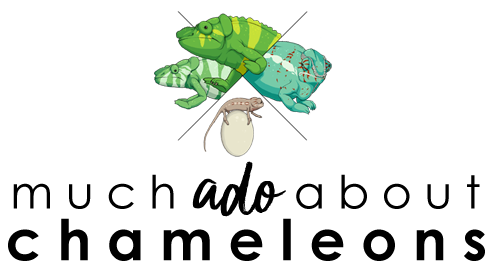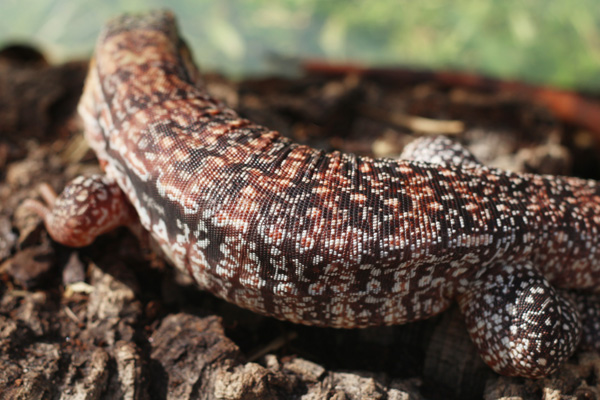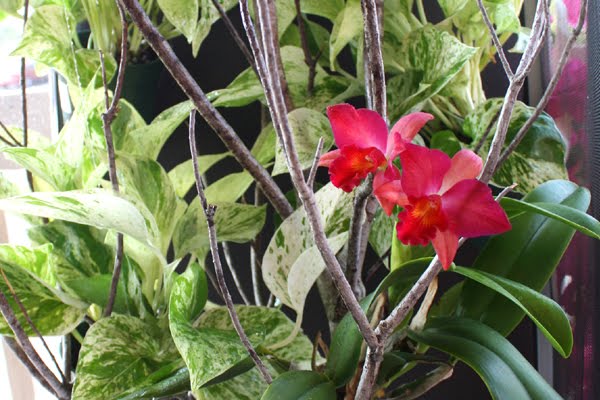 |
 Below is the single clutch of panther chameleon (F. pardalis) eggs that I currently have incubating. This is a special clutch (batch of eggs) to me because it is the only time I will be breeding my current, and favorite, pair of panthers.
Below is the single clutch of panther chameleon (F. pardalis) eggs that I currently have incubating. This is a special clutch (batch of eggs) to me because it is the only time I will be breeding my current, and favorite, pair of panthers.Also, it is a controversial clutch as well.
This is because panther chameleons come in different morphs (called locales because each color variety is specific to a location on their native Madagascar and named after that area). In this case, both parents are a mix of several different locales and are considered crosses. My male Daedalus is a Nosy Faly and Ambanja cross, while the female Azura is a Nosy Be, Ambanja, and Sambava cross. The male was an accidental cross, where his mother was purchased as one locale and turned out to be another. While the female was an intentional cross, produced from a pure locale father and a crossed mother by someone who was curious. To me they are fantastic chameleons, great pets, and beautiful animals. But not everyone would agree.
The Controversy
In the chameleon community crossing panther chameleon locales on purpose is quite taboo, inciting very angry responses. While the the anti-cross people make good points, there is a lot of unnecessary anger and hostility towards both the animals themselves and their owners/breeders. The most important reason is that females of all locales look essentially identical - there is no definitive way to identify that a female belongs to one locale versus another, so the worry is that you buy a female for a breeding project and finding yourself with a clutch of chameleons that look nothing like you're supposed to. And sometimes not all male offspring look like a mix, so you may have some look like parent A while others look like parent B and others a mix of the two. Another good point is that dishonest breeders will sell the pure-looking male offspring and the females as pure locale animals for top-dollar, while wholesaling the rest to pet stores for them to deal with as they may. So the worries are not unfounded - the origins of two of my males are examples of mislabeled animals.
 |
| Daedalus is a Nosy Faly and Ambanja cross. |
It is also a problem that stems at the source, straight from the importers in Madagascar that are in charge of picking out and exporting out the different locales purchased by breeders across the world. For example, for orders comprised of Nosy Faly panthers are often filled with Ambanja females to meet the quota, which results in captive hatched clutches of crosses like my male, Daedalus. This is why breeders, while they need wild blood every few generations to strengthen the lines, are cautious about using wild caught females because they may not prove to be what they are labelled as.
Intense Opinions
It's understandable that if you run a breeding program that might be your livelihood, taking all these precautions against crosses is important. Your reputation as reputable breeder may be at stake. But the anger seen in the chameleon community surrounding personal opinions on crosses is a little disproportional, in my opinion. I once saw a man go on a forum to share photos of his favorite breeder male, and after getting a few doubts regarding purity of the animal, this man was in such a terrified frenzy that he was ready to sell his beloved animal and destroy all the eggs he had incubating from this male just to distance himself from crosses. Another man also sought confirmation that his male's identity what what he thought it was and announced, when relieved that it was, that he was glad he did not have a "retarded mutt."
I have gotten plenty of attacks as well for being perfectly happy with my crosses, and for having sought to purchase/breed only crossed panthers due to several reasons including curiosity. I have even gotten hate male regarding my male, Daedalus, telling me that he is worthless and ugly. When arguing with one man about his attitude on the matter, he told me "you stick to your bargin brand crosses an leave the real business [to others.]" Besides not being able to spell very well, this man's opinion is revealing about how many people feel about crosses. It is true that due to lower demand they do not usually sell for as much, which is a plus for keepers who may not be able to afford the $250-300 a pure panther is worth. But it is unfortunate that people feel that my breeding projects and preferences, as well as those of others like me, are not of the same caliber and that they choose to demean us.
My Thoughts on the Matter
As a biologist, I believe in mixing and tinkering to see what happens. I have a lot of curiosity and a lot of admiration at the different color combinations and patterns that occur in crossed panthers that do not occur naturally. I think my crosses are the most beautiful panthers I have owned (and I have owned pures are well) and cannot wait to see what the next generation brings. Others, like me, are also interested in seeing what happens, as as long as all parties involved are responsible, there should be no harm done.
 |
| Daedalus and Azura, both crosses. |
As a conservation ecologist, I also know that none of these panthers are ever going to contribute to a re-population effort in the wild to preserve the locales and species. None of the animals that we breed in the private sector will ever join conservation projects like those run by zoos. Therefore, there is no bigger-picture reason to keep the locales pure and only pure, as these animals are strictly for the pet trade and not for any professional genetic or conservation projects.
Also, having one does not negate the other. Like we have pure lab and poodle breeders we can have labradoodle breeders simultaneously; there will always be people breeding for purity and others breeding for curiosity. The existence of one does not negate the other.
And so I breed crosses. I and the people on my hatchling waiting list are excited to see what happens, what emerges from those 23 perfect little while eggs. Each will be different from its sibling, and how each one matures is a mystery. Some will look very blue and others may look much more red, with varying combinations of these and orange, yellow, and green. It will be exciting to see what happens. It is just a shame that they should be demeaned and despised by others in the community, for no fault of their own.
So in conclusion, to each their own. Enjoy these beautiful, amazing animals and let others do the same.
I, for one, eagerly await the mystery.












Hi Olimpia,
ReplyDeletebabies hatched?
Have you got any picture from the baby caméléon
what is locality Azura?
Hi Bruno. Yes, they hatched out over a year ago, in October of 2012. Here is the thread on the hatchlings: http://muchadoaboutchameleons.blogspot.com/2013/01/panther-chameleon-breeding-raising.html
DeleteAzura is a Nosy Be x Sambava x Ambanja cross.
This comment has been removed by a blog administrator.
ReplyDeleteI liked this article and I'm glad you touched on the conservation ecology side as this is also a passion of mine and I'm finishing my degree in conservation studies as well. The biggest reason I would want lines to stay pure is because I love to keep animals as they are naturally; and then to be able to keep them! Of course, the reason we have so many subspecies of panthers is due to natural cross breeding anyway. So I understand both sides. However, I was upset you made the comparison between Labradoodles and crossed locales. Labradoodles are a poor example, in my opinion, because although a few breeders may strive for the health and well-being of the litter, the fad seems to be about money. Breeders who breed/sell/own either labs or poodles usually do not approve purposeful crosses which is why the dogs used for these crosses do not come from the best lines. I've run into more ill-bred anything-doodles because, unfortunately, they've become so popular many who breed aren't breeding for the right reasons. The "creator" of Labradoodles even wrote/spoke out about regretting the direction the cross has gone. There will probably always be those who like pure lines and those who like crosses. I like pure lines because it preserves a bit of history. There are many breeds of domestic animals that are dwindling, which I believe is very unfortunate. In the natural world those pure lines may not be around forever (for different reasons, not all bad!) - therefore having a line that is pure is an awesome way to look back at what was. Just my thought on the matter. I will also add that some crosses are my favorites to look at but the natural locales would still win out for me because I love the idea of having my own piece of nature inside with me to interact with (that probably sound weird - I like my little zoo!).
ReplyDeleteI really appreciate your informative blog! I just received my first panther and I love researching everything about them. I'm not sure of the locale of mine, I'm hoping he'll color up in the next few months so I can figure it out. All of your information has been presented objectively (when needed) and in a grammatically-correct format! When I think of new things to research, I read through your blog first. Thanks for all the helpful information! I love getting another scholar's point of view on things.
Thanks for the kind words about the blog!
DeleteI totally understand your points. As a huge dog lover as well I know the horrors of what people are doing to certain breeds and designer crosses alike. Even when I was looking for breeders for the dog I wanted (a sheltie) I rejected most of the ones in Florida because they had terrible dogs, weak and feeble-looking from bad breeding practices. I only wanted to make the point that both groups of people will always co-exist, those who breed pures and those who breed crosses. There are unethical, money-driven people on all sides of the spectrum but there will always be people who do one or the other. With the vast majority of professional panther breeders sticking to pure locales, I don't think we have anything to fear from them disappearing!
Another point that I don't think I made above is that certain looks we associate with pure locales are purely selective breeding! Take the example of Nosy Be panthers, that brilliant solid turquoise blue is not what you find out on the island of Nosy Be. In the wild their colors lean more towards teals and green-blues, with moderate red freckling. The solid blue that is so coveted today is a product of selectively breeding the bluest of the blue together over and over. It doesn't really represent the locale as it occurs naturally.
Great information! Thank you.
ReplyDeleteGreat information! Thank you.
ReplyDeleteThanks for sharing this interesting information in details.
ReplyDeleteเว็บย่อลิ้ง
เว็บย่อลิ้งค์
ย่อลิ้ง
ย่อurl
ย่อเว็บ